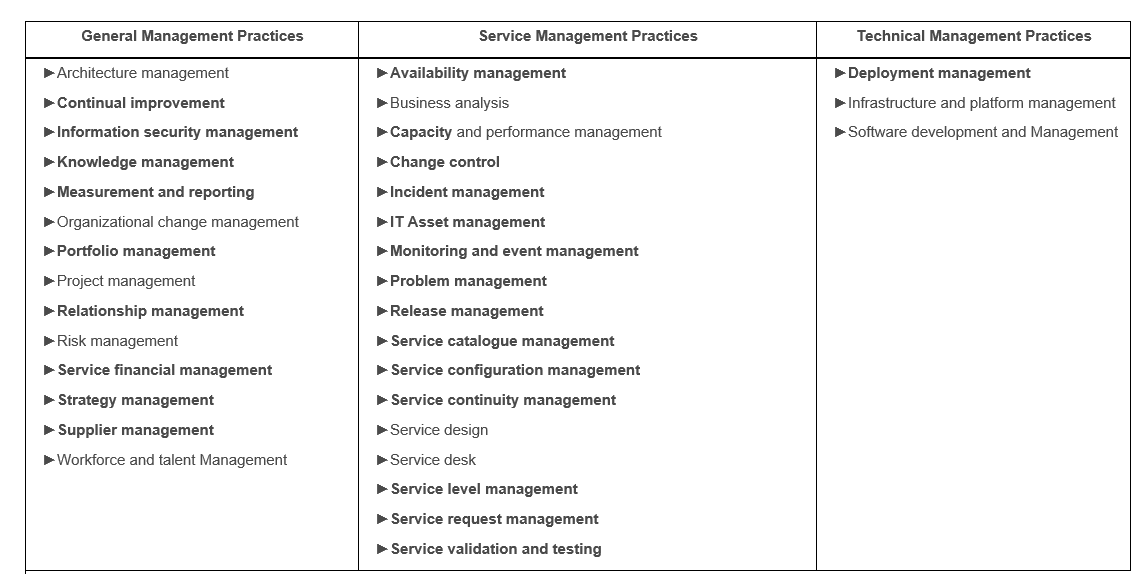Goodbye ITIL Version 3.0, Hello ITIL Version 4.0
In January 2021, AXELOS announced that the Information Technology Infrastructure Library (ITIL) version 3.0 will be discontinued by the end of 2021and replaced by the new ITIL version 4.0. framework for IT and digitally enabled services in the world. It provides comprehensive, practical, and proven guidance for establishing an effective service management system.” ITIL “helps define the direction of the service provider with a clear capability model and aligns them to the business strategy and customer needs.” ITIL also provides “a common glossary of terms for businesses using IT-enabled services”.
Per AXELOS, “ITIL is the most widely recognized
“Launched in 2019, ITIL 4.0 has evolved from the previous version by reshaping much of the established ITSM practices in the wider context of customer experience, value streams and digital transformation, as well as embracing new ways of working, such as Lean, Agile, and DevOps.”
“The updated framework will focus on facilitating value co-creation via a service value system (SVS). The SVS represents how different components and activities can work together, in any type of organization, to facilitate value creation through IT enabled services.”
So, what does this mean?
ITIL was developed by the British government in the late 1980’s to provide best practice guidance primarily for IT operational organizations such as service desks and data center operations. Over time, ITIL has evolved – to continue to provide best practice guidance to organizations – and is no longer limited to IT organizations by broadening this guidance to any organization that provides service management and service delivery. ITIL 4.0 aligns that guidance with such practices as Dev Ops, software development lifecycles (SDLCs) and software development and delivery practices such as Agile, LEAN and Scrum. Version 4.0 includes industry concepts such as organizational change management, project management and risk management principles to support service management delivery and adoption.
ITIL 3.0 focused on “the service lifecycle,” made up of 26 service management processes and four functions. The processes described operational characteristics that should be optimally present in mature organizations and were grouped across five areas:
- Service strategy
- Service design
- Service transition
- Service operation
- Continual service improvement (CSI)
ITIL 4.0 moves away from being a collection of processes to be performed and has adopted a “systems approach” to delivering service. At its core, ITIL 4.0 focuses on the inputs and outputs of the service value system with the primary goal of the co-creation of value to support business objectives. The main objective of the service value system is the creation of value: a meaningful, beneficial, and useful product or service.
New or evolved concepts that come with are the four dimensions that should be considered when determining the management, delivery and operations of a service management framework and organization. These four dimensions are:
- Organizations and people.
- Information and technology.
- Partners and suppliers.
- Value streams and processes.
The ITIL service value system is comprised of five core components, all working together to create value:
- The service value chain – This is the central element in ITIL 4.0 comprised of 6 reusable activities used to create service value streams, such as defined workflows to deliver services.
- Management practices – These 34 practices build upon the 26 ITIL 3.0 processes and are organized into 3 groups: General Management Practices, Service Management Practices and Technical Management Practices. ITIL hasn’t thrown the 3.0 process “baby” out with the 4.0 “bathwater” but rather has extended the list of practices that organizations should master and advises organizations to focus on the flexible and practical and to “right-size” management practices to meet the specific needs of the business.
- Governance – The governing arm of the organization provides strategic direction (similar to Service Strategy in 3.0) to the service management organization and checks for organizational alignment with priorities and objectives.
- Guiding principles – This addition to the framework includes industry-recognized recommendations adopted from the Practitioners guide.
- Continual improvement (no longer continual service improvement) – ITIL 4.0 recommends that organizations use a continual improvement register (CRI) to manage improvement ideas. Improve is the last activity in the service value chain and continual improvement should be built into every aspect of the service value system.
The six activities within the ITIL service value chain are:
- Plan–create a common understanding of what the service provider organization needs to achieve and how it will be achieved.
- Improve–Ensure the continual improvement of products, services, and practices.
- Engage–Collaborate and communicate with stakeholders to make sure their needs are well-understood and are being met.
- Design and transition–Create new or changed products and services to meet stakeholder expectations across quality, cost, and time to market.
- Obtain/build–Create or procure service components and ensure that they’re available when and where they’re needed to agreed specifications.
- Deliver and support–Deliver and support services according to agreed specifications and stakeholder expectations.
ITIL 4.0 Management Practices
ITIL 4.0 includes many/most of the former ITIL 3.0 process areas but has expanded and reorganized the list of processes into 3 new lists of practices – with the focus on building organizational capability and expertise to perform various needed operations as opposed to following process steps.

* Bolded items were present in V3.
Underpinning service value chain activities are the Seven Guiding Principles. The principles consist of general, common sense guidance based loosely on Agile concepts:
- Focus on value.
- Start where you are.
- Progress iteratively with feedback.
- Collaborate and promote visibility.
- Think and work holistically.
- Keep it simple and practical.
- Optimize and automate.
To recap, ITIL 4.0 practitioners need to understand:
- Service Value System and the 5 core components
- 7 Guiding Principles
- 4 Dimensions of Service Management
- Service Value Chain and 6 Service Value Chain Activities
- 34 Management Practices
ITIL 4.0 provides broader, general best practice guidance on – not only running IT operations – but has expanded that guidance to encompass providing service – following the service lifecycle – within a larger business world ecosystem complete with suppliers, service providers, consumers, and customers to better align with other industry recommended practices, such formal project management and Agile software development, used to deliver products and services to customers.




